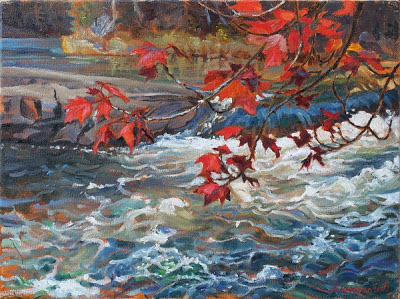Cedar and Juniper (oil on canvas, 5 x 7 in)
11 December finds me "Out Back" of our house in Bishops Mills, Ontario, shortly after sunrise, doing my first snow painting of the winter, en plein air. This is not fresh snow. The Cedars have shrugged it from their flexible leaves, but the stiff prickly Juniper still holds its burden - the shadowed sides of which I delight in painting blue, as snow brings the colours of the sky to the ground. This is also the first painting of our winter "Landscape Art & Science" project.
In "Winter Woodlots of Eastern Ontario", we will be visiting and painting private woodlots and public forests, guided to special spots by people who are familiar with them, learning the history and management of the woodlots, sharing what we know about the natural history of forests - and especially getting me out in the snow, where it's most exciting to be painting!
At the end of the winter we will publish another blog-based book book like "Art and Science in the South Nation Watershed", which is available online at Lulu.com or you can contact me at karstad (at) pinicola.ca
When I took Fred out to see the site of today's painting, he said, “Oh, that's close enough to the Yellowjacket Board Waypoint [0.2 km SSE Bishops Mills, (50m site), 44.87036°N 75.70016°W] that we won't need to make a new waypoint.” Back at the house, he e-mailed me 15 pages of notes for this site, dating back to 12 July 1981, just after we'd bought this land from the Weirs, when his mother made a synoptic collection of plants centred here for our first daughter. The site is named for Yellowjackets (Vespula) that, around 1995, had excavated a 10cm hole under a cover object he'd placed beside the Juniper in the painting. The hole persisted for years, though the Juniper has spread over it and is now 4 metres in diameter.
Other activities here were the naming of a Dogwood bush beside the Junipers as “Goat Berries,” by the daughter, several episodes of suppression of Cathartic Buckthorn, annual recording the blooming of Taraxacum palustre (Oldfield Dandelion), Senecio pauerculus (Balsam Ragwort), and Penstemon hirsutus (Hairy Beardtongue). Today Fred found a White Pine (Pinus strobus) seedling on the edge of the Cedars (Thuja occidentalis), which he's planning to subsidize with household and garden waste.
So by doing woodlots, we're heading for much more detailed knowledge of the sites painted, and we anticipate that we'll be recording more lore than we will be discovering previously unknown phenomena or populations.
This painting is available for $275. If you are interested in purchasing it, please contact Aleta
This painting is available for $275. If you are interested in purchasing it, please contact Aleta




I love this, Aleta. We have snow-covered junipers, and a cedar (not native to Alberta, but to my home province of BC) so I really like this painting.
ReplyDeleteKay, Alberta, Canada
An Unfittie’s Guide to Adventurous Travel
This one is lovely!! A perfect little painting for beginning the new series.
ReplyDeleteKaren